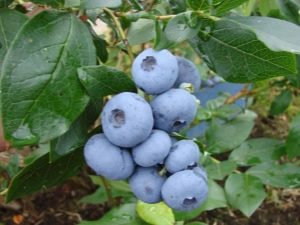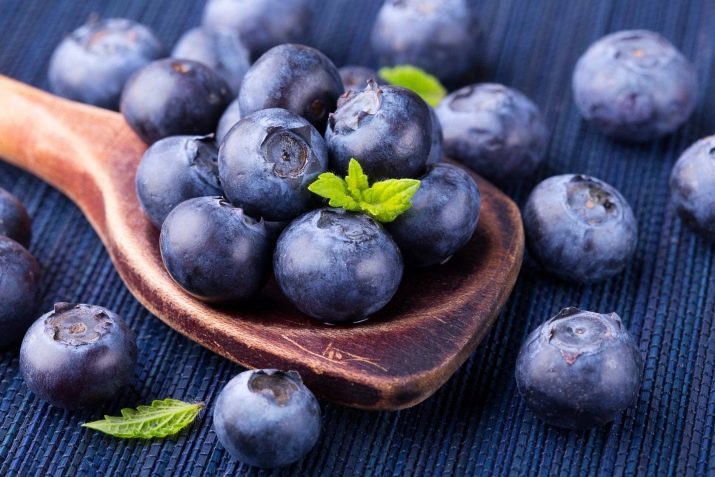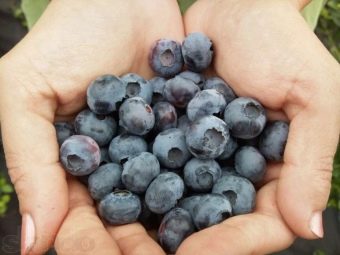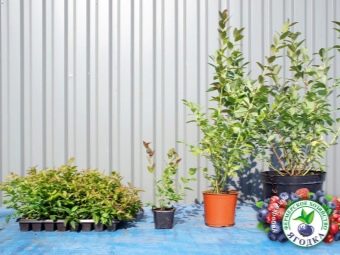Useful properties of blueberry "Bonus": how to grow?

In America, which is considered the birthplace of blueberry, this shrub is grown on a large scale. Berry is actively used in the food industry.In the same place, breeders constantly produce new varieties. Gardeners of Russia are happy to grow this tasty berry on their plots. One of the new varieties of blueberries called "Bonus" has already taken root in our open spaces. Many gardeners are ready to share a description of this variety and its features.
Features
Blueberry “Bonus” is a tall variety, which blooms later than other blueberry species, but this shrub is considered to be frost-resistant. Cold temperatures are necessary for the plant to bear fruit well in the summer. 800 hours (minimum) temperatures below 7 degrees are required for blueberries. Winter frosts within 30 degrees for these berries are not critical.
Given the characteristics of this variety, blueberries can not cover, if the temperature, of course, do not drop to 40 degrees. But gardeners are still insured using agrofibre for this purpose.
Most of all for the "bonus" is suitable light soil, well drained, containing a sufficient amount of organic matter.
Description
Appearance is not particularly different from other varieties. You need to thoroughly know the description of the variety to find the differences. In the height of the shrub reaches one and a half meters, and sometimes it can be slightly higher. This blueberry has sprawling branches, which are usually 130 cm wide. The branches of an adult tree are powerful - their diameter is about 3 cm. New branches grow, new plants grow, increasing the height of the plant.
Separately, it should be said about the leaves. Smooth, in the shape of an ellipse, like many other varieties. In the summer, they acquire a bright green color. But by the autumn the leaves turn red, and the bush changes its appearance. Many consider this variety of blueberry not only a source of delicious and healthy berries, but also a garden decoration.
From each bud there are from 5 to 10 flowers of pink color. They are shaped like bells. A distinctive feature of this variety is large berries, which can be more than 3 cm in diameter. They have a pale blue color, dense skin and a waxy coating. To taste the fruit is very sweet. Perhaps because of this, this variety attracts more than others.
Specifications
For Siberians and residents of the Far East, this variety is a real gift. It is he who takes root well and bears fruit in harsh climatic conditions, although “Bonus” is very much loved in the southern part of Russia and in the middle lane.
Middle-late “Bonus” begins to ripen at the end of July, and in some regions even in mid-August and lasts until the last days of September. Berries for a long time retain their properties and appearance. You can freeze them - from the fruit turns out delicious jam and jam, rich in vitamins. From one bush you can collect from 5 to 8 kilograms of berries. The peak of fruiting comes when blueberries turn 3, and sometimes 4 years.
Living conditions
Blueberry seedlings today are very popular. Therefore, in the garden stores you can buy a variety of varieties. And at least according to the rules, trees are planted in the fall, they can be purchased and planted in the spring. The main thing: to comply with the recommendations of experienced gardeners that the trees take root, and then gave a good harvest over time.
Any sort of blueberry (and "Bonus" as well) loves areas where there is a lot of light and air. Wet, light and acidic soils - the best option. Sandy and peaty soils will be favorable for shrubs, while heavy and dense ones are not suitable for blueberries.
For the proper cultivation of berries is very important to comply with the level of acidity that it needs (PH - 3.5-4.8). This parameter is easily determined using litmus strips, which can be purchased in hotels with chemicals. The set with strips has an indicator and instructions for use. You can determine the level of acidity and visually - just look at the soil after the rain. If in the hollows the water has a rainbow surface, and after drying on the soil a brown precipitate is visible, the soil has an increased acidity.
With low acidity, the situation can be remedied by introducing sour peat, sulfur or acidic ammonium into the soil. Then the optimum level is maintained by watering the plant with oxalic acid, citric acid or acetic acid diluted in it. Increased acidity can be lowered with lime or wood ash. Liming is enough to hold once every three years.
Any manipulation of the soil produced 6 months before planting. If you plan to plant trees in the fall, soil treatment is done in the spring. Due to its low acidity, blueberries are affected by various diseases. A high - leads to the dying of life, and the tree will no longer bear fruit.
That is why it is important to keep the level of acidity at that level, which is necessary for blueberries of this variety.
Landing
If in most cases the trees are planted in the fall, then opinions differ about the blueberry. Testimonials from experienced gardeners suggest that the autumn planting gives a chance to form a root system well, but there is a possibility that the young tree will freeze out if it is not properly covered. Therefore, those who are cautious, plant bushes in the spring, when it becomes warm and there is confidence that there will be no frost anymore.
The pit for the seedling is dug one meter deep, since this variety belongs to tall shrubs. The distance between the trees should be from 1.5 to 2 meters.
The pits are filled with water and they are waiting for it to be fully absorbed. Roots of seedlings need to straighten well before sprinkling with soil. After planting, mulching is performed using rotted sawdust.
Care
When growing and caring, a timely role is played by top-dressing with properly selected substances and watering, as is the case with other varieties of blueberries.
- Watering is given special attention. Light soils, which are selected for the “Bonus” variety, quickly absorb moisture and dry out. If you do not water blueberries in a timely manner, the berries will become small, and this is the most large-fruited variety, so you need to remember this. In hot weather, the bushes should be sprayed with water, but not during the day, but towards the evening.
- Top dressing is carried out 3 times a year: in the initial growing season, when buds are in bloom and when crops are harvested. Spring is the right time for nitrogen fertilizers. When the fruits appeared, nitrogen fertilizers do not make, but comes the turn of calcium. It is this dressing that affects the density and size of the berries. Potassium sulfate - the last stage after fruiting.
- We must not forget about the timely weeding. Weeds pick up nutrients from the roots, depriving blueberries of light. The roots of the berries are not very deep, so care should be taken when loosening the soil.
- Pruning is needed after 3 years of growth.. The right time for this is early spring or late autumn. From the age of five rejuvenating pruning is required, in which old branches and unpromising shoots are removed.
- The advantages of the “Bonus” are that this variety is resistant to many diseases.to which other fruit shrubs are prone. But prevention from time to time does not hurt. Drug packs contain dosage information. Closer to winter in areas with a cold climate, bushes need to be protected from possible frosts by bending the branches to the ground, and by covering them with any suitable material, avoiding plastic film.
Compliance with simple rules and recommendations will allow each year to harvest a good harvest and enjoy the taste of the wonderful blueberry berries of the “Bonus” variety.
How to grow blueberry "Bonus", see the next video.


































